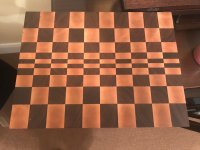GoingMyWay
Member
live4ever said:We are all cheapskates here. It's just that Festool makes a lot of nice machines, and if you are trying to get one of them to do what others do even better, you're depriving yourself of the pleasure that comes from having the best tool for the job. At least that's how they've warped my brain into thinking. LOL. But in all seriousness, while the RO is a really amazing and versatile sander, it's not a great finish sander compared to other sanders in Festool's lineup (ETS, ETS-ECs, RTS/DTS...). And in woodworking, most of what you do is finish sand. So I don't see the RO as the only sander I'd like to own. Just my opinion of course. It still might be the first sander for you, but it ain't gonna be your last. [scared]
Consistent widths is no problem in theory, but it's inherently going to be less perfect than say, a tablesaw with a good fence. On a cutting board, even one hundredth of an inch difference strip to strip will give you something that needs to be routered or sanded out. The approach should work fine as long as you have a way to deal with any unevenness you end up with - in your case the router sled. Or a buddy with a drum sander. Yes, you'd be able to slowly even out the board with the Rotex, but your result is likely to be smooth but a little wavier than the dead-nuts flat you'll get with other approaches.
I don't know if this is a one-off or few-off project for you or if you plan on making a lot of these, but usually folks that make lots of cutting boards end up with a drum sander for good reason. Oh, did I mention we're really good at spending your money here?
Maybe ETS EC 150/5 would be a better first choice. I do like that it's $110 cheaper than the RO150.
Let's see how well or unwell the first cutting board turns out. LOL - this could turn into a big disaster. I have delusions of grandeur of going into the mass production end grain cutting board business, but I know I'm completely unequipped to do that and I'd never really make money selling them.


